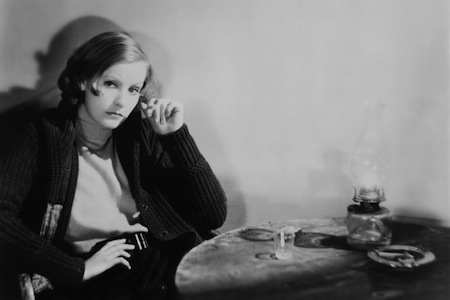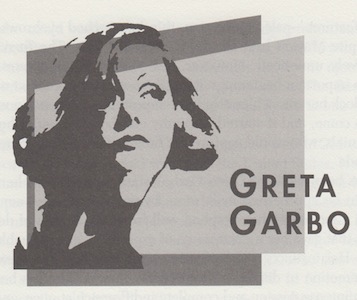Born: September 18, 1905, Stockholm, Sweden
Died: April 15, 1990, New York, NY
Her indifference to public opinion made her career unique.
—Alexander Walker
During the silent era, Hollywood was eager to distribute its films to wider audiences and considered international markets a prime source for additional box office profits. To tap them, studio heads set out to find foreign actors and directors who had established a following, bring them to America and place them in movies that had universal appeal. Talent scouts first began scouring the European film community for emerging stars. In 1925, MGM founder Louis B. Mayer went shopping for directors in Stockholm and found Mauritz Stiller, fresh off the success of The Saga of Gösta Berling (1924). Stiller returned to the United States with Mayer, under the condition they bring a promising young actress with them. Within a year, Mayer would send Stiller back to Sweden and begin to mold his protégé, Greta Garbo, into one of his top stars. Before long, Garbo would become one of the world’s most recognizable faces and leave a lasting impression on the world of cinema.
The Film 100
1. W.K. Laurie Dickson
2 Edwin S. Porter
3. Charlie Chaplin
4. Mary Pickford
5. Orson Welles
6. Alfred Hitchcock
7. Walt Disney
8. D.W. Griffith
9. Will Hays
10 Thomas Edison
11. John Wayne
12. J.R. Bray
13. Billy Bitzer
14. Jesse Lasky
15. George Eastman
16. Sergei Eisenstein
17. André Bazin
18. Irving Thalberg
19. Thomas Ince
20. Marlon Brando
21. Louis B. Mayer
22. Greta Garbo
23. Robert Flaherty
24. Lon Chaney
25. Anita Loos
26. George Méliès
27. Adolph Zukor
28. John Gilbert
29. Max Fleischer
30. John Ford
31. William Fox
32. George Lucas
33. Linwood Gale Dunn
34. Eadweard Muybridge
35. Katharine Hepburn
36. Winsor McCay
37. Stanley Kubrick
38. Buster Keaton
39. James Agee
40. Fritz Lang
41. Marcus Loew
42. Cedric Gibbons
43. James Cagney
44. Ben Hecht
45. Ingmar Bergman
46. Humphrey Bogart
47. Leon Schlesinger
48. Louella Parsons
49. Roger Corman
50. Edith Head
51. Bernard Herrmann
52. Gary Cooper
53. Mike Todd
54. Ernst Lubitsch
55. Sidney Poitier
56. Saul Bass
57. Billy Wilder
58. Bette Davis
59. Erich von Stroheim
60. Max Factor
61. Auguste and Louis Lumière
62. Woody Allen
63. Clark Gable
64. David O. Selznick
65. Gregg Toland
66. Lillian Gish
67. William Cameron Menzies
68. Lucille Ball
69. Samuel Rothafel
70. Akira Kurosawa
71. Marilyn Monroe
72. Vittorio De Sica
73. Natalie Kalmus
74. Gene Siskel and Roger Ebert
75. Willis O’Brien
76. Shirley Temple
77. Yakima Canutt
78. Sam Peckinpah
79. Jackie Coogan
80. Federico Fellini
81. Leni Riefenstahl
82. Steven Spielberg
83. Sam Warner
84. Jean-Luc Godard
85. Robert De Niro
86. Fred Astaire
87. Francis Ford Coppola
88. Ted Turner
89. Clint Eastwood
90. Dalton Trumbo
91. Dennis Hopper
92. Richard Hollingshead
93. Melvin Van Peebles
94. John Chambers
95. Mack Sennett
96. Martin Scorsese
97. Karl Struss
98. Busby Berkeley
99. John Hubley
100. John Cassavetes
Greta Garbo’s film career was quite unlike that of any other Hollywood actress of the time; she did not work her way up through hundreds of auditions and dozens of bit parts. Her stardom was manufactured by L.B. Mayer and the staff at Metro. Mayer decided to make Garbo an instant star, and her first day in Los Angeles was spent at the salon of makeup artist Max Factor, who created a special look for the actress that accentuated her trademark features—pale complexion, thin lips, arched eyebrows and long lashes. Despite Mayer’s best efforts, Garbo’s first film, The Torrent (1926), went relatively unnoticed. However, her second, The Temptress (1926), marked two important beginnings: it began an exclusive contract with MGM that would lock her into a lucrative but tempestuous relationship with Mayer for years to come, and it started a lengthy collaboration with photographer William Daniels, who would capture the famous Garbo gaze in nearly every film she made.
Much has been made of Greta Garbo’s statuesque beauty; her looks are purported to be appreciated even more by women than by men. She was graced with a face that photographed well from any angle and deep, penetrating eyes that gave her a great range of expression, an invaluable asset for silent films. Her instincts as a performer were unerring; she knew the right amount of emotion to display in front of the camera. She has been said to convey both intense passion and complete indifference at once, and much of the fascination with her acting stemmed from her ability to reveal intimate thoughts while remaining aloof. Her screen persona was a sophisticated mixture of icy remoteness and aristocratic fortitude. This complexity made Garbo one of the most compelling actresses in film history and allowed her to portray some of the strongest female roles ever filmed.
When she was teamed with MGM’s top leading man, John Gilbert, in Flesh and the Devil (1927), a reported affair between the two fueled the success of the picture, and Garbo’s popularity soared. As their off-screen relationship generated greater public attention, the demand for more of their films intensified. Their second film together was perhaps the most anticipated event in the silent era. However, before pairing with Gilbert in Love (1927), Garbo demanded more money and top billing from Mayer—and got them.
Mayer guarded his prized commodity very carefully, and the romance of Garbo and Gilbert, his two finest stars, would become a sore point with him. When Garbo eventually tired of Gilbert’s affections, Mayer was asked to act as a liaison between them, and the relationship between Mayer and Gilbert quickly became strained. Gilbert felt Mayer was encouraging Garbo to leave him, and Mayer grew tired of Gilbert’s constant accusations. As their discussions became increasingly heated, the two men elevated their enmity into a well-publicized feud. The breakup of Garbo and Gilbert ultimately led to the release of Gilbert from his MGM contract, but they remained close until Gilbert’s early death in 1936.
After thirteen silent films, Garbo was uncomfortable with the transition to sound. She felt uncertain about the reaction to her voice, deep and thickly accented. But her first talkie, Anna Christie (1930), ended her worries. She crossed over to sound films with tremendous box office success and was nominated for the Best Actress Academy Award that year. Despite her beauty, she could easily handle the masculine determination required for Queen Christina (1938). It was not her finest film, but Christina did capture Garbo’s incredibly magnetic allure. Although she spent much of the film walking around in pants, her femininity didn’t wane. The final shot of her courageous, pensive countenance staring into the sea is one of film’s most enduring images.
As critical successes mounted, Garbo bargained with MGM until she eventually became the highest-paid woman in the United States. Her largest paycheck came in 1930, a whopping $275,000. She was given her choice of director, preferring MGM’s sure-handed craftsmen like Clarence Brown, who directed most of Garbo’s twenty-seven films. Whether at home in the poignant melancholy of Grand Hotel (1932), or trying her hand at cynical desperation in Ernst Lubitsch’s Ninotchka (1939), Garbo also welcomed any chance to showcase her more-lighthearted skills. In Ninotchka, Lubitsch stripped away the old, brooding Garbo to create a sophisticated yet fussy performance that revealed her gifts for comic timing and delivery.
Timing would, in fact, turn out to be her most legendary quality, for in 1941 she made a career move unique in the history of cinema. After sixteen years in film, at the age of thirty-six, Greta Garbo withdrew completely from the public eye, becoming a staunch recluse until her death in 1990, and leaving only her flickering images to sustain her memory.
Greta Garbo, Hollywood’s greatest European import ever was arguably the world’s most popular actress and the most celebrated woman of the silent era. Although Mary Pickford ranks higher on this list for her all-around contributions to the earliest days of Hollywood and for her seminal role in the star system, Garbo perhaps achieved greater international recognition during her heyday because of the maturation of the industry and the greater number of filmgoers worldwide. Throughout her career, she enjoyed the rare stature of a goddess; Garbo set a standard for sex appeal in the movies that has rarely been matched. Also, an important part of Garbo’s legend is her reclusiveness. She shunned public events and rarely was seen outside of her films. This enigmatic quality, coupled with her regal features and glamorous air, added to her celebrity, and she has become a cinematic mystery, baffling millions of admiring fans with her complex and magnetic persona.
To read all the republished articles from ‘The Film 100,’ go to Reintroducing the Film 100 here on Keyframe.





